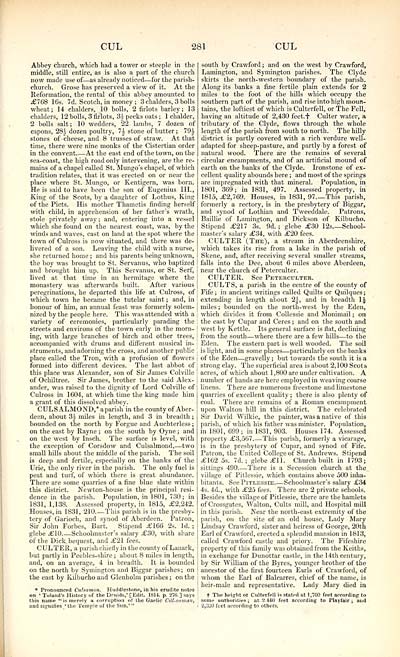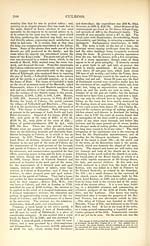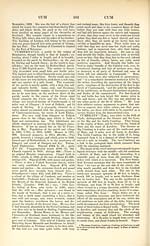Topographical, statistical, and historical gazetteer of Scotland > Volume 1
(363) Page 281
Download files
Complete book:
Individual page:
Thumbnail gallery: Grid view | List view

CUL
281
CUL
Abbey church, which had a tower or steeple in the
middle, still entire, as is also a part of the church
now made use of — as already noticed — for the parish-
church. Grose has preserved a view of it. At the
Reformation, the rental of this abbey amounted to
£768 16s. 7d. Scotch, in money ; 3 chalders, 3 bolls
wheat; 14 chalders, 10 bolls, 2 firlots barley ; 13
chalders, 12 bolls, 3 firlots, 3h pecks oats; 1 chalder,
2 bolls salt; 10 wedders, 22 lambs, 7 dozen of
capons, 28h dozen poultry, "i stone of butter ; 79^
stones of cheese, and 8 trusses of straw. At that
time, there were nine monks of the Cistertian order
in the convent At the east end of the town, on the
sea-coast, the high road only intervening, are the re-
mains of a chapel called St. Mungo's chapel, of which
tradition relates, that it was erected on or near the
place where St. Mungo, or Kentigern, was born.
He is said to have been the son of Eugenius III.,
King of the Scots, by a daughter of Lothus, King
of the Picts. His mother Thametis finding herself
with child, in apprehension of her father's wrath',
stole privately away ; and, entering into a vessel
which she found on the nearest coast, was, by the
winds and waves, cast on land at the spot where the
town of Culross is now situated, and there was de-
livered of a son. Leaving the child with a nurse,
she returned home ; and his parents being unknown,
the boy was brought to St. Servanus, who baptized
and brought him up. This Servanus, or St. Serf,
lived at that time in an hermitage where the
monastery was afterwards built. After various
peregrinations, he departed this life at Culross, of
which town he became the tutelar saint ; and, in
honour of him, an annual feast was formerly solem- j
nized by the people here. This was attended with a
variety of ceremonies, particularly parading the
streets and environs of the town early in the morn-
ing, with large branches of birch and other trees,
accompanied with drums and different musical in-
struments, and adorning the cross, and another public
place called the Tron, with a profusion of flowers j
formed into different devices. The last abbot of
this place was Alexander, son of Sir James Colville I
of Ochiltree. Sir James, brother to the said Alex- |
ander, was raised to the dignity of Lord Colville of
Culross in 1604, at which time the king made him
a grant of this dissolved abbey.
CULSALMOND,*aparish in the county of Aber-
deen, about 3k miles in length, and 3 in breadth ;
bounded on the north by Forgue and Auchterless ;
on the east by Rayne ; on the south by Oyne ; and
on the west by Insch. The surface is level, with
the exception of Corsdow and Culsalmond, — two
small hills about the middle of the parish. The soil
is deep and fertile, especially on the banks of the
Urie, the only river in the parish. The only fuel is
peat and turf, of which there is great abundance.
There are some quarries of a fine blue slate within
this district. Newton-house is the principal resi-
dence in the parish. Population, in 1801, 730 ; in
1831, 1,138. Assessed property, in 1815, £2,242.
Houses, in 1831, 210.— This parish is in the presby-
tery of Garioch, and synod of Aberdeen. Patron,
Sir John Forbes, Bart. Stipend £166 2s. Id. ;
glebe £10. — Schoolmaster's salary £30, with share
of the Dick bequest, and £21 fees.
CULTER, a parish chiefly in the county of Lanark,
but partly in Peebles-shire ; about 8 miles in length,
and, on an average, 4 in breadth. It is bounded
on the north by Symington and Biggar parishes ; on
the east by Kilbucho and Glenholm parishes ; on tbe
* Pronounced Cuhamon. Huddlestone, in his erudite notes
on ' Tnland's History of the Druids,' [Edit. 1814. p. 27(i.] says
this name "is merely a corruption of the Gaelic CiU-saman,
and signifies ' the 'temple of the Sun.'"
south by Crawford ; and on the west by Crawford,
Lamington, and Symington parishes. The Clyde
skirts the north-western boundary of the parish.
Along its banks a fine fertile plain extends for 2
miles to the foot of the hills which occupy the
southern part of the parish, and rise into high moun-
tains, the loftiest of which is Culterfell, or The Fell,
having an altitude of 2,430 feet.j Culter water, a
tributary of the Clyde, flows through the whole
length of the parish from south to north. The hilly
district is partly covered with a rich verdure well-
adapted for sheep-pasture, and partly by a forest of
natural wood. There are the remains of several
circular encampments, and of an artificial mound of
earth on the banks of the Clyde. Ironstone of ex-
cellent quality abounds here ; and most of the springs
are impregnated with that mineral. Population, in
1801, 369; in 1831, 497. Assessed property, in
1815, £2,769. Houses, in 1831, 97.— This parish,
formerly a rectory, is in the presbytery of Biggar,
and synod of Lothian and Tweeddale. Patrons,
Baillie of Lamington, and Dickson of Kilbucho.
Stipend £217 3s. 9d. ; glebe £30 12s School-
master's salary £34, with £20 fees.
CULTER (The), a stream in Aberdeenshire,
which takes its rise from a lake in the parish of
Skene, and, after receiving several smaller streams,
falls into the Dee, about 6 miles above Aberdeen,
near the church of Peterculter.
CULTER. See Petercdlter.
CULTS, a parish in the centre of the county of
Fife; in ancient writings called Quilts or Quilques;
extending in length about 2t, and in breadth 1J
miles ; bounded on the north-west by the Eden,
which divides it from Collessie and Monimail ; on
the east by Cupar and Ceres ; and on the south and
west by Kettle. Its general surface is flat, declining
from the south — where there are a few hills — to the
Eden. The eastern part is well wooded. The soil
is light, and in some places — particularly on the banks
of the Eden — gravelly ; but towards the south it is a
strong clay. The superficial area is about 2,100 Scots
acres, of which about 1,800 are under cultivation. A
number of hands are here employed in weaving coarse
linens. There are numerous freestone and limestone
quarries of excellent quality ; there is also plenty of
coal. There are remains of a Roman encampment
upon Walton hill in this district. The celebrated
Sir David Wilkie, the painter, was a native of this
parish, of which his father was minister. Population,
in 1801, 699; in 1831, 903. Houses 174. Assessed
property £3,567. — This parish, formerly a vicarage,
is in the presbytery of Cupar, and synod of Fife.
Patron, the United College of St. Andrews. Stipend
£162 5s. 7d. ; glebe £11. Church built in 1793;
sittings 490 There is a Secession church at the
village of Pitlessie, which contains above 500 inha-
bitants. See Pitlessie Schoolmaster's salary £34
4s. 4d., with £25 fees. There are 2 private schools.
Besides the village of Pitlessie, there are the hamlets
of Crossgates, Walton, Cults mill, and Hospital mill
in this parish. Near the north-east extremity of the
parish, on the site of an old house, Lady Mary
Lindsay Crawford, sister and heiress of George, 20th
Earl of Crawford, erected a splendid mansion in 1813,
called Crawford castle and priory. The Fifeshire
property of this family was obtained from the Keiths,
in exchange for Dunottar castle, in the 14th century,
by Sir William of the Byres, younger brother of the
ancestor of the first fourteen Earls of Crawford, of
whom the Earl of Balcarres, chief of the name, is
heir-male and representative. Lady Mary died in
f The height of Culterfell in stated at 1,700 feet according to
some authorities ; at 2.440 feet according to Playfair ; and
2,330 feet according to others.
281
CUL
Abbey church, which had a tower or steeple in the
middle, still entire, as is also a part of the church
now made use of — as already noticed — for the parish-
church. Grose has preserved a view of it. At the
Reformation, the rental of this abbey amounted to
£768 16s. 7d. Scotch, in money ; 3 chalders, 3 bolls
wheat; 14 chalders, 10 bolls, 2 firlots barley ; 13
chalders, 12 bolls, 3 firlots, 3h pecks oats; 1 chalder,
2 bolls salt; 10 wedders, 22 lambs, 7 dozen of
capons, 28h dozen poultry, "i stone of butter ; 79^
stones of cheese, and 8 trusses of straw. At that
time, there were nine monks of the Cistertian order
in the convent At the east end of the town, on the
sea-coast, the high road only intervening, are the re-
mains of a chapel called St. Mungo's chapel, of which
tradition relates, that it was erected on or near the
place where St. Mungo, or Kentigern, was born.
He is said to have been the son of Eugenius III.,
King of the Scots, by a daughter of Lothus, King
of the Picts. His mother Thametis finding herself
with child, in apprehension of her father's wrath',
stole privately away ; and, entering into a vessel
which she found on the nearest coast, was, by the
winds and waves, cast on land at the spot where the
town of Culross is now situated, and there was de-
livered of a son. Leaving the child with a nurse,
she returned home ; and his parents being unknown,
the boy was brought to St. Servanus, who baptized
and brought him up. This Servanus, or St. Serf,
lived at that time in an hermitage where the
monastery was afterwards built. After various
peregrinations, he departed this life at Culross, of
which town he became the tutelar saint ; and, in
honour of him, an annual feast was formerly solem- j
nized by the people here. This was attended with a
variety of ceremonies, particularly parading the
streets and environs of the town early in the morn-
ing, with large branches of birch and other trees,
accompanied with drums and different musical in-
struments, and adorning the cross, and another public
place called the Tron, with a profusion of flowers j
formed into different devices. The last abbot of
this place was Alexander, son of Sir James Colville I
of Ochiltree. Sir James, brother to the said Alex- |
ander, was raised to the dignity of Lord Colville of
Culross in 1604, at which time the king made him
a grant of this dissolved abbey.
CULSALMOND,*aparish in the county of Aber-
deen, about 3k miles in length, and 3 in breadth ;
bounded on the north by Forgue and Auchterless ;
on the east by Rayne ; on the south by Oyne ; and
on the west by Insch. The surface is level, with
the exception of Corsdow and Culsalmond, — two
small hills about the middle of the parish. The soil
is deep and fertile, especially on the banks of the
Urie, the only river in the parish. The only fuel is
peat and turf, of which there is great abundance.
There are some quarries of a fine blue slate within
this district. Newton-house is the principal resi-
dence in the parish. Population, in 1801, 730 ; in
1831, 1,138. Assessed property, in 1815, £2,242.
Houses, in 1831, 210.— This parish is in the presby-
tery of Garioch, and synod of Aberdeen. Patron,
Sir John Forbes, Bart. Stipend £166 2s. Id. ;
glebe £10. — Schoolmaster's salary £30, with share
of the Dick bequest, and £21 fees.
CULTER, a parish chiefly in the county of Lanark,
but partly in Peebles-shire ; about 8 miles in length,
and, on an average, 4 in breadth. It is bounded
on the north by Symington and Biggar parishes ; on
the east by Kilbucho and Glenholm parishes ; on tbe
* Pronounced Cuhamon. Huddlestone, in his erudite notes
on ' Tnland's History of the Druids,' [Edit. 1814. p. 27(i.] says
this name "is merely a corruption of the Gaelic CiU-saman,
and signifies ' the 'temple of the Sun.'"
south by Crawford ; and on the west by Crawford,
Lamington, and Symington parishes. The Clyde
skirts the north-western boundary of the parish.
Along its banks a fine fertile plain extends for 2
miles to the foot of the hills which occupy the
southern part of the parish, and rise into high moun-
tains, the loftiest of which is Culterfell, or The Fell,
having an altitude of 2,430 feet.j Culter water, a
tributary of the Clyde, flows through the whole
length of the parish from south to north. The hilly
district is partly covered with a rich verdure well-
adapted for sheep-pasture, and partly by a forest of
natural wood. There are the remains of several
circular encampments, and of an artificial mound of
earth on the banks of the Clyde. Ironstone of ex-
cellent quality abounds here ; and most of the springs
are impregnated with that mineral. Population, in
1801, 369; in 1831, 497. Assessed property, in
1815, £2,769. Houses, in 1831, 97.— This parish,
formerly a rectory, is in the presbytery of Biggar,
and synod of Lothian and Tweeddale. Patrons,
Baillie of Lamington, and Dickson of Kilbucho.
Stipend £217 3s. 9d. ; glebe £30 12s School-
master's salary £34, with £20 fees.
CULTER (The), a stream in Aberdeenshire,
which takes its rise from a lake in the parish of
Skene, and, after receiving several smaller streams,
falls into the Dee, about 6 miles above Aberdeen,
near the church of Peterculter.
CULTER. See Petercdlter.
CULTS, a parish in the centre of the county of
Fife; in ancient writings called Quilts or Quilques;
extending in length about 2t, and in breadth 1J
miles ; bounded on the north-west by the Eden,
which divides it from Collessie and Monimail ; on
the east by Cupar and Ceres ; and on the south and
west by Kettle. Its general surface is flat, declining
from the south — where there are a few hills — to the
Eden. The eastern part is well wooded. The soil
is light, and in some places — particularly on the banks
of the Eden — gravelly ; but towards the south it is a
strong clay. The superficial area is about 2,100 Scots
acres, of which about 1,800 are under cultivation. A
number of hands are here employed in weaving coarse
linens. There are numerous freestone and limestone
quarries of excellent quality ; there is also plenty of
coal. There are remains of a Roman encampment
upon Walton hill in this district. The celebrated
Sir David Wilkie, the painter, was a native of this
parish, of which his father was minister. Population,
in 1801, 699; in 1831, 903. Houses 174. Assessed
property £3,567. — This parish, formerly a vicarage,
is in the presbytery of Cupar, and synod of Fife.
Patron, the United College of St. Andrews. Stipend
£162 5s. 7d. ; glebe £11. Church built in 1793;
sittings 490 There is a Secession church at the
village of Pitlessie, which contains above 500 inha-
bitants. See Pitlessie Schoolmaster's salary £34
4s. 4d., with £25 fees. There are 2 private schools.
Besides the village of Pitlessie, there are the hamlets
of Crossgates, Walton, Cults mill, and Hospital mill
in this parish. Near the north-east extremity of the
parish, on the site of an old house, Lady Mary
Lindsay Crawford, sister and heiress of George, 20th
Earl of Crawford, erected a splendid mansion in 1813,
called Crawford castle and priory. The Fifeshire
property of this family was obtained from the Keiths,
in exchange for Dunottar castle, in the 14th century,
by Sir William of the Byres, younger brother of the
ancestor of the first fourteen Earls of Crawford, of
whom the Earl of Balcarres, chief of the name, is
heir-male and representative. Lady Mary died in
f The height of Culterfell in stated at 1,700 feet according to
some authorities ; at 2.440 feet according to Playfair ; and
2,330 feet according to others.
Set display mode to: Large image | Transcription
Images and transcriptions on this page, including medium image downloads, may be used under the Creative Commons Attribution 4.0 International Licence unless otherwise stated. ![]()
| Gazetteers of Scotland, 1803-1901 > Topographical, statistical, and historical gazetteer of Scotland > Volume 1 > (363) Page 281 |
|---|
| Permanent URL | https://digital.nls.uk/97441902 |
|---|
| Description | Volume first. A-H. |
|---|---|
| Attribution and copyright: |
|

